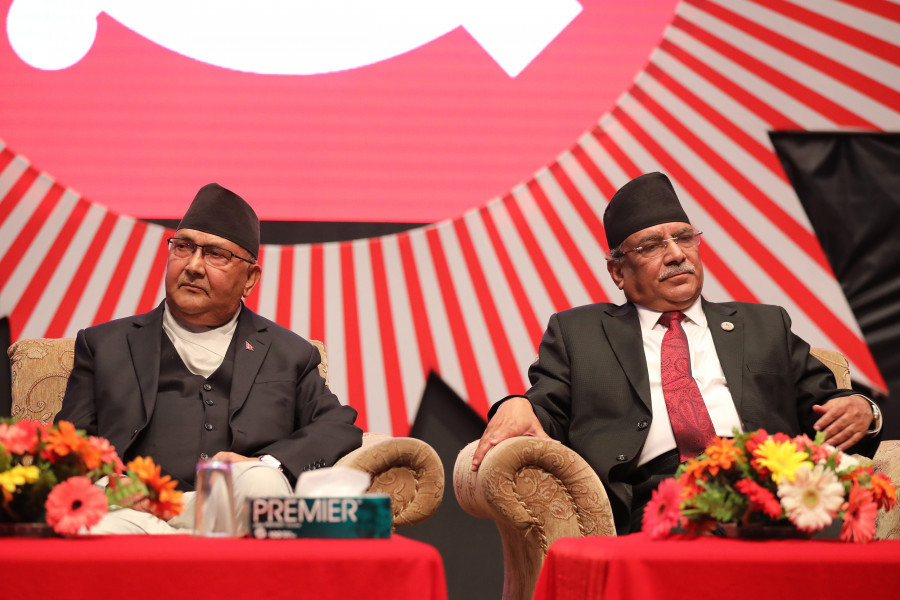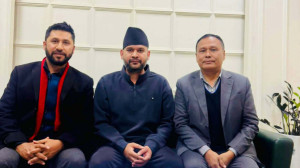Politics
Nepal Communist Party has split politically, but law blocks its legal split
Deadline has expired to claim legitimacy by either side of the party as per Section 44 of Political Parties Act-2017, which calls for making such claims within 30 days after dispute arises.
Prithvi Man Shrestha
The Election Commission’s decision–or indecision for that matter–on the legitimacy dispute of the Nepal Communist Party may mean there is no way the party can split unless one of the factions wants to register itself as a new party.
The poll body on Sunday said that based on details and information provided to it, it can only recognise the Nepal Communist Party, which was formed in May 2018, as the legitimate party, whose chairs are KP Sharma Oli and Pushpa Kamal Dahal.
The Nepal Communist Party, however, has split in two–politically–after Oli’s decision to dissolve the House.
One faction is led by Oli. The other faction is led by Dahal, and Madhav Kumar Nepal has been made the other chair.
Politically, there are now two parties–the Nepal Communist Party (Oli faction) and Nepal Communist Party (Dahal-Nepal faction).
However, the commission has refused to recognise either of the factions as the legitimate one.
Stating that decisions taken by the both sides after the dispute surfaced were against the statute of the party, the commission has decided to notify both chairs of the Nepal Communist Party–Oli and Dahal–that the commission will maintain the existing details of the party.
The commission decision on Sunday came 33 days days after the dispute surfaced between the two sides, which, legal experts say, means that neither faction can claim legitimacy as per Section 44 of Political Parties Act—2017.
As per this provision, a faction that seeks to claim the ownership of the original party, stamp, flag and symbol needs to submit papers with all the documents to the commission along with signatures of at least 40 percent of the party’s Central Committee members within 30 days after a dispute arises.
But it has been more than 30 days since the dispute arose between the two sides.
The dispute in the party surfaced after both factions held separate Central Committee meetings of their own on December 22–two days after President Bidya Devi Bhandari dissolved the House of Representatives on the recommendation of Oli and announced fresh elections for April 30 and May 10.
The Oli-led faction decided to expand the Central Committee to 1,199 from 445. But while submitting its claims to the commission, it said its Central Committee has 1,501 members. The same day, the Dahal-Nepal led faction decided to oust Oli as the party chair and elevated Nepal as the chair, declaring that it has two chairs. The next day, it notified the commission about its decision.
Based on their respective decisions, both sides had requested the commission to update the new developments but they failed to follow the party statute, which was drafted in May 2018, according to the commission.
“If we go by Section 44 of the Political Parties Act, it appears that the door is closed for either faction of the Nepal Communist Party to claim legitimacy because the deadline has already expired,” said an official at the commission.
Once a faction makes claims of legitimacy as per Section 44 (1), the commission seeks response from another faction by giving a 15-day deadline.
After studying documents submitted by both factions, the commission gives legitimacy to one faction that provides the signatures of 40 percent of the party’s Central Committee members.
Another faction then is allowed to form a separate party and gets registered as a new party, according to Section 44 (6) of Political Parties Act.
But questions have been raised whether the commission may give legitimacy to any faction after the lapse of the deadline.
“A wayout can be explored if either side comes up with an application that the process of dispute settlement be initiated already under Section 51 of the Act which prevented them from making claims as per Section 44 of the law,” said the commission official.
As per Section 51, a party needs to apply at the commission to update details if the party’s name, statute, regulation, stamp, flag and officer-bearers are changed or amended.
Only if the commission is satisfied with the submitted details does it recognise and update the changes that it has been notified of. If not, as per Clause 25 (6) of the Political Parties Regulations, the commission will recognise the existing details of the party.
A legal expert who had worked at the commission, however, told the Post on condition of anonymity because he is associated with another state institution, that the law has not given either faction of the Nepal Communist Party any room to claim legitimacy under Section 44 as the deadline of making claims has already expired.
“Whether the dispute can be settled under this provision will also depend on how any faction in the party makes claims,” said the legal expert. “They can claim in the application that the dispute surfaced a few days ago instead of more than 30 days ago.”
According to him, in the absence of a clear provision, some disputes can be settled as per the principle of “doctrine of necessity”,’ but there is a question if the election body can invoke the doctrine of necessity, as it is the court which usually decides based on this principle.
Either faction of the Nepal Communist Party can split the party as per Section 33 of Political Parties Act-2017.
As per Section 33 (2), a faction needs to secure support of 40 percent of members of both the Central Committee and the Parliamentary Party.
But currently there is no Parliamentary Party since the House was dissolved on December 20. The House dissolution case is currently being heard by the Constitutional Bench of the Supreme Court.
“Only if the House is restored by the court or the prime minister introduces an ordinance can the party split,” said senior advocate Balkrishna Neupane. “Or else, there is no possibility of a split in the Nepal Communist Party under Section 33 of Political Parties Act.”
As per Section 33 (2), a separate party can be formed by splitting a party with the support of at least 40 percent members of the Parliamentary Party and Central Committee of the existing party.
In April last year, the Oli government had introduced an ordinance to the Political Parties Act, easing the party split, as it had recommended provisions that the party could be split with the support of 40 percent of either Central Committee members “or” Parliamentary Party members. The “and” provision was replaced by “or” provision,
After strong protests within the party and outside, the government had withdrawn the ordinance.
As per Section 33 (2) of Political Parties Act, besides splitting the party with 40 percent support of the Central Committee and Parliamentary Party members, a separate party can also be formed by entering into a new party or with the involvement of them alongside others.
But Section 33 (3) is even more prohibitive when it comes to splitting the party. As per this provision, a party formed as per Section 33 (2) cannot be split for at least five years from the date it is registered with the Election Commission.
This has raised questions whether the Nepal Communist Party which was formed after the merger of then CPN-UML and CPN (Maoist Centre) in May 2018, could split at all.
At least two current and former officials of the commission told the Post that Section 33 (3) does not prevent the Nepal Communist Party from splitting as the provision was essentially made to prevent yet another split of a party formed after splitting the original party with the support of 40 percent of Central Committee members.
As the Nepal Communist Party was formed after the merger as per Section 10 of Political Parties Act, Section 33 (3) is not applicable to it, according to them.
One of the officials said that a lack of clarity in the provision has given space for multiple legal interpretations.
But senior advocate Neupane said that provision applies to the Nepal Communist Party too, because this party should also be considered a new party even though it was formed through the process of merger.
“The key intention of Section 33 (3) is to prevent frequent splits in a party,” Neupane told the Post.
With the legal chances for the split looking slim, both factions might have to stay together for a prolonged period, while running “their organisations” separately.
Radhesyam Adhikari, a National Assembly member from the Nepali Congress who is also an advocate, said that one remedy could be that either faction of the party can challenge the commission’s latest decision at the Supreme Court to pave the way for a split.
“Had the commission given legitimacy to one faction, such a situation would not have arisen. The dissatisfied faction would have had a chance to go to the court,” said Adhikari. “But the commission failed to resolve the dispute despite being a competent authority to do so.”




 19.12°C Kathmandu
19.12°C Kathmandu













%20(1).jpg&w=300&height=200)

